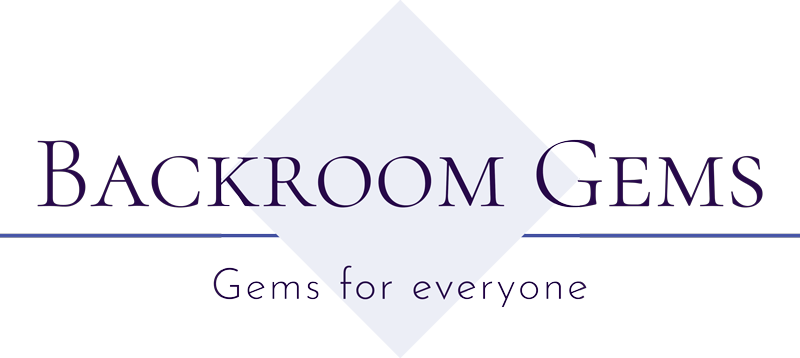Garnet: Not Just a Red Stone
 When most people hear “garnet” their mind goes to the rich, deep red gem that we all know and love. Try to order any January birthstone jewelry and that’s the color that you will see! But what if you don’t like red? What if you want a gem that stands out from the typical garnet? Don’t worry, there’s options for you! The garnet family has many varieties that come in a range of colors, so there is something for everyone to enjoy and love.
When most people hear “garnet” their mind goes to the rich, deep red gem that we all know and love. Try to order any January birthstone jewelry and that’s the color that you will see! But what if you don’t like red? What if you want a gem that stands out from the typical garnet? Don’t worry, there’s options for you! The garnet family has many varieties that come in a range of colors, so there is something for everyone to enjoy and love.
The word garnet is thought to derive from a couple different places. One popular notion is that it comes from the Latin word granatus, which means pomegranate.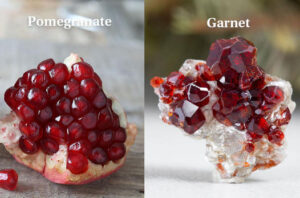 If you’ve seen the fruit and a specimen of uncut garnet, you can definitely see the resemblance! Another thought is that it derives from the 14th-century Middle English word gernet, meaning ‘dark red’. Regardless of where the word originates, this 2nd wedding anniversary stone has been a popular gem since the bronze age! Since ancient times, garnet’s traditional red color was associated with the heart and blood. Because of this, people believed garnets possessed the power to counter melancholy, compel the heart to great deeds, prevent hemorrhage, and improve circulation. In Persia garnets were considered a talisman from nature’s forces like storms and lightning. It was thought that garnet could signal approaching danger by turning pale.
If you’ve seen the fruit and a specimen of uncut garnet, you can definitely see the resemblance! Another thought is that it derives from the 14th-century Middle English word gernet, meaning ‘dark red’. Regardless of where the word originates, this 2nd wedding anniversary stone has been a popular gem since the bronze age! Since ancient times, garnet’s traditional red color was associated with the heart and blood. Because of this, people believed garnets possessed the power to counter melancholy, compel the heart to great deeds, prevent hemorrhage, and improve circulation. In Persia garnets were considered a talisman from nature’s forces like storms and lightning. It was thought that garnet could signal approaching danger by turning pale.
Although it is generally associated with that well known dark red or red violet hue, garnet species are found in every color with blue being the rarest having been first reported in the 1990s. Some garnets can even exhibit the color-change phenomenon similar to the very rare alexandrite! The garnet family is one of the most complex in the gem world. This is because it is not a single species, but rather is composed of multiple species and varieties. In fact, there are more than twenty species of garnet, but only five of them are considered commercially important as gemstones. Those five include pyrope, almandine, spessartine, grossular (varieties of which are hessonite or cinnamon-stone and tsavorite), and andradite. Another species, uvarovite, is a green type that usually forms in crystals that are too small to cut. Although it can sometimes be seen set as clusters in jewelry.
The garnet family is one of the most complex in the gem world. This is because it is not a single species, but rather is composed of multiple species and varieties. In fact, there are more than twenty species of garnet, but only five of them are considered commercially important as gemstones. Those five include pyrope, almandine, spessartine, grossular (varieties of which are hessonite or cinnamon-stone and tsavorite), and andradite. Another species, uvarovite, is a green type that usually forms in crystals that are too small to cut. Although it can sometimes be seen set as clusters in jewelry.
Red garnet is one of the most common and widespread gemstones as it is found in metamorphic rocks on just about every continent. But not all garnets are as abundant as the red ones. Tsavorite is a much rarer variety because it requires unusual rock chemistries and special conditions to form, but the gorgeous green color makes it all worth it! All garnets have essentially the same crystal structure, but they all vary in chemical composition.
Let’s explore some of the different species!
Spessartite
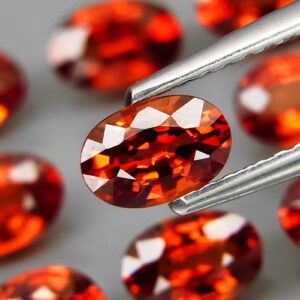 Spessartite is the yellow to orangish red form of garnet. The word spessartite is synonymous with spessartine, though they are used in different contexts. Spessartite is more frequently used in the gem trade, while spessartine is more often used in the mineral trade. The names derived from the Spessart Mountains in Bavaria, Germany where the gem originated. It is thought that spessartite garnets stimulate all aspects of creativity in both energy and ability, and also encourage the wearer to chase after their dreams, visions, and goals. It is also believed to induce optimism, confidence, and action.
Spessartite is the yellow to orangish red form of garnet. The word spessartite is synonymous with spessartine, though they are used in different contexts. Spessartite is more frequently used in the gem trade, while spessartine is more often used in the mineral trade. The names derived from the Spessart Mountains in Bavaria, Germany where the gem originated. It is thought that spessartite garnets stimulate all aspects of creativity in both energy and ability, and also encourage the wearer to chase after their dreams, visions, and goals. It is also believed to induce optimism, confidence, and action.
Rhodolite
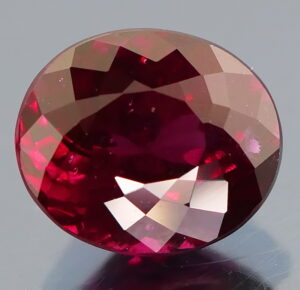 Rhodolite is a name for the variety of garnet that ranges in color from lavender pink to raspberry rose or raspberry red and from purplish violet (grape) to purplish red. It was first described in North Carolina with the Greek name “rhodon” in honor of its “rose-like” hue. Rhodolite garnet is said to encourage love, kindness, and compassion while promoting self-worth and stimulating intuition. It also is a gem of inspiration with fire energy, having an aura of passion and heat.
Rhodolite is a name for the variety of garnet that ranges in color from lavender pink to raspberry rose or raspberry red and from purplish violet (grape) to purplish red. It was first described in North Carolina with the Greek name “rhodon” in honor of its “rose-like” hue. Rhodolite garnet is said to encourage love, kindness, and compassion while promoting self-worth and stimulating intuition. It also is a gem of inspiration with fire energy, having an aura of passion and heat.
Hessonite
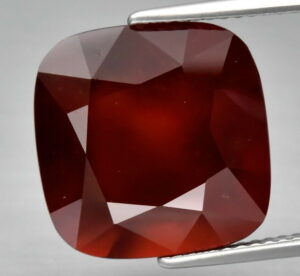 Hessonite garnet is a variety of grossular type that is most well-known for its warm yellowish red hue. While most grossularite is green, hessonite’s unique color has earned the gem the nickname cinnamon stone. The best-known deposits are in Sri Lanka, however it can be found in various other countries around the world, including the United States! It is believed to encourage a mellow vibe and have a strong spiritual value. Hessonite is also said to prevent the wearer from gossiping and promote success.
Hessonite garnet is a variety of grossular type that is most well-known for its warm yellowish red hue. While most grossularite is green, hessonite’s unique color has earned the gem the nickname cinnamon stone. The best-known deposits are in Sri Lanka, however it can be found in various other countries around the world, including the United States! It is believed to encourage a mellow vibe and have a strong spiritual value. Hessonite is also said to prevent the wearer from gossiping and promote success.
Malaya
The Malaya garnet gets its name from the Swahili “malaia”, which means “outcast” or “out of family.” This is due to its unique color and mineral attributes that separates it from the typical deep red or violet red varieties. 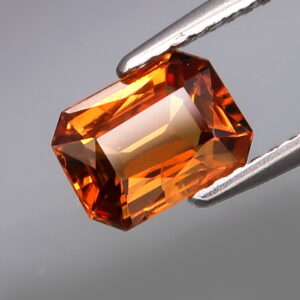 Malaya garnets have hues that range in pinkish orange, reddish orange, or yellowish orange and were first discovered in the 1960s in the Umba River Valley, which remains the primary source. The miners would cast aside these types of garnets since they didn’t fit into any categories that were purchased from buyers, thus giving them their title of outcast. It is believed that these garnets symbolize regeneration and resurrection and allow the wearer to regain lost energy.
Malaya garnets have hues that range in pinkish orange, reddish orange, or yellowish orange and were first discovered in the 1960s in the Umba River Valley, which remains the primary source. The miners would cast aside these types of garnets since they didn’t fit into any categories that were purchased from buyers, thus giving them their title of outcast. It is believed that these garnets symbolize regeneration and resurrection and allow the wearer to regain lost energy.
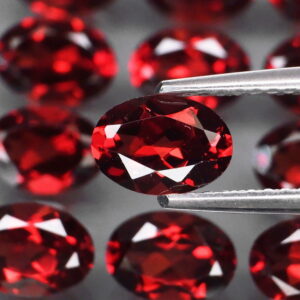 So, if you are searching for something to gift the Capricorn or Aquarius in your life, know that you have options! Even though January has only one birthstone, at least it’s one that has plenty of varieties and species to choose from. All you have to do is choose a color! If you want to go classic, you can never go wrong with the timeless, stunning red that garnet is famous for. There’s a reason it has been widely used and loved for hundreds of years… it’s gorgeous! But everyone likes to be unique, so why not add a little spice to that red!? If you need help deciding, you can always visit Backroom Gems to find the perfect gem for you.
So, if you are searching for something to gift the Capricorn or Aquarius in your life, know that you have options! Even though January has only one birthstone, at least it’s one that has plenty of varieties and species to choose from. All you have to do is choose a color! If you want to go classic, you can never go wrong with the timeless, stunning red that garnet is famous for. There’s a reason it has been widely used and loved for hundreds of years… it’s gorgeous! But everyone likes to be unique, so why not add a little spice to that red!? If you need help deciding, you can always visit Backroom Gems to find the perfect gem for you.
